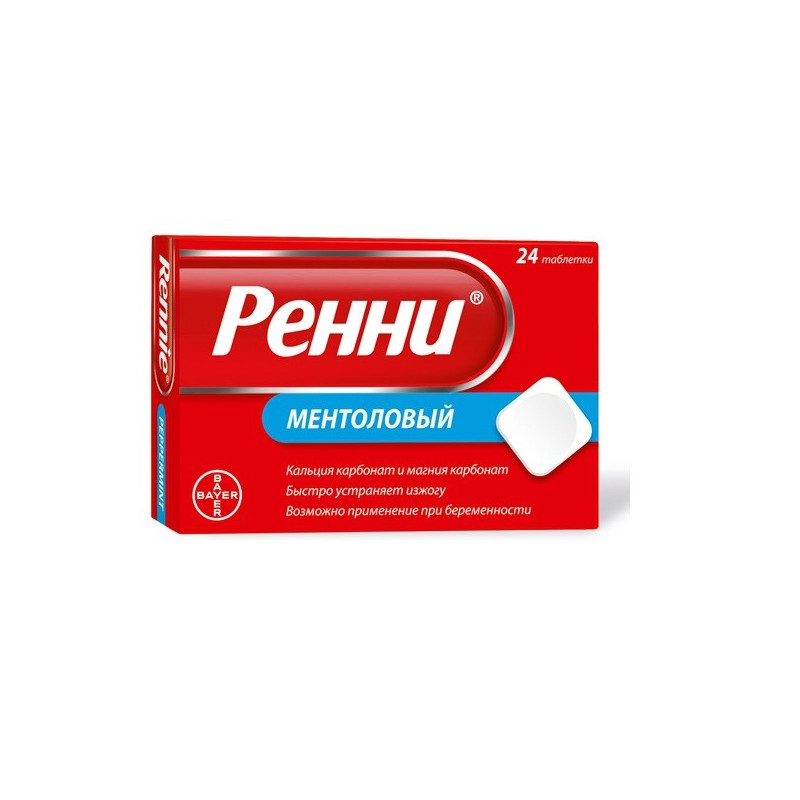



 All payments are encrypted via SSL
All payments are encrypted via SSL
 Full Refund if you haven't received your order
Full Refund if you haven't received your order
Rennie
Calcium carbonate + Magnesium carbonate.
Chewable tablets, chewable pills [cooling taste].
Square pills from white to white with a light brown shade of color with concave surfaces, engraved with “RENNIE” on both sides, with a smell of menthol. Small spots are allowed (for chewable pills [cooling flavor]).
1 chewable pill contains
Active ingredients: calcium carbonate 680 mg, magnesium carbonate basic 80 mg.
Excipients: sucrose 475 mg, pregelatinized corn starch 20 mg, potato starch 13 mg, talc 33.14 mg, magnesium stearate 10.66 mg, light liquid paraffin 5 mg, menthol flavoring (peppermint oil, maltodextrin, gum arabic, silicon dioxide) 13 mg, lemon flavor (lemon oil, maltodextrin, water) 0.2 mg.
1 chewable pill [cooling flavor] contains
Active ingredients: calcium carbonate 680 mg, magnesium carbonate basic 80 mg. Excipients: sucrose 475 mg, pegelatinized corn starch 20 mg, potato starch 13 mg, talc 33.14 mg, magnesium stearate 10.66 mg, light liquid paraffin 5 mg, xylitol 100 (xylitol (min 95%), polydextrose) 25.2 mg, cooling flavor (diethyl malonate, maltodextrin, menthol, methyl lactate, E1450 modified starch, iso-pullule) 15 mg, menthol flavor (maltodextrin, menthol, E1450 modified starch) 15 mg.
Antacid.
The drug contains antacid substances - Calcium carbonate and magnesium carbonate, which provide a quick and long-lasting neutralization of excess hydrochloric acid of the gastric juice, thereby has a protective effect on the gastric mucosa. Achieving a positive effect within 3-5 minutes due to the good solubility of pills and high calcium content.
Pharmacokinetics. As a result of Rennie's interaction with gastric juice, soluble calcium and magnesium salts are formed in the stomach. The degree of absorption of calcium and magnesium from these compounds depends on the dose of the drug. The maximum level of absorption is 10% calcium and 15-20% magnesium.A small amount of absorbed calcium and magnesium is excreted through the kidneys. When kidney function is impaired, plasma levels of calcium and magnesium may increase. In the intestine of soluble salts are formed insoluble compounds that are excreted in the feces.
Symptoms associated with increased acidity of gastric juice and reflux esophagitis: heartburn, sour eructation, recurrent pain in the stomach, feeling of fullness or heaviness in the epigastric region, dyspepsia (including caused by error in diet, medication, abuse of alcohol, coffee nicotine), dyspepsia pregnant.
Severe renal failure, hypercalcemia, hypophosphatemia, nephrocalcinosis, hypersensitivity to the components of the drug, sucrose / isomaltase deficiency, fructose intolerance, glucose-galactose malabsorption, children under 12 years of age.
When used in recommended doses, the drug does not pose a danger to the fetus or child.
Inside
Adults and children over 12 years old: unless otherwise recommended by a doctor, chew 1-2 pills when symptoms appear or chew in the mouth until completely dissolved. If necessary, you can repeat the drug after 2 hours.
The maximum daily dose is 11 tablets.
If the recommended doses are taken, the drug is well tolerated, however, in very rare cases, allergic reactions are possible: rash, angioedema, and Anaphylactic reactions.
Prolonged use of the drug in high doses in patients with impaired renal function can cause hypermagnesemia, hypercalcemia, alkalosis, which are manifested by nausea, vomiting, muscle weakness. In this case, you should cancel the drug and immediately consult a doctor.
Changes in the acidity of gastric juice, during the use of antacids, can lead to a decrease in the rate and extent of absorption of other drugs, while taking it, so drugs should be taken 1-2 hours before or after taking antacids.
Tetracycline antibiotics, fluoroquinolones, cardiac glycosides, levothyroxine, iron preparations, fluorides, phosphates - while the use of antacids reduces the absorption of these drugs.
Thiazide diuretics - when taken concurrently with antacids, the concentration of calcium in blood serum should be regularly monitored.
In the appointment of the drug to patients with impaired renal function should regularly monitor the concentration of magnesium, phosphorus and calcium in the serum.
Patients with impaired renal function is not recommended for a long time to take the drug in high doses.
The use of Rennie in high doses may increase the risk of kidney stones.
The instruction to patients with diabetes mellitus: 1 pill Renny contains 475 mg of sucrose.
If the use of the drug is ineffective, you should consult your doctor for advice.
Does not affect.
On 6 pills in a thermowelled aluminum / PVC blister. On 2, 4, 6, 8 and 16 blisters together with the application instruction in a cardboard pack.
On 12 pills in a thermowelled aluminum / PVC blister. On 1, 2, 3, 4 and 8 blisters together with the application instruction in a cardboard pack.
At a temperature not higher than 25 ° С. Keep out of the reach of children.
Chewable tablets: 5 years.
Chewable pills [cooling flavor]: 3 years.
Do not use after expiration date.
Over the counter.
